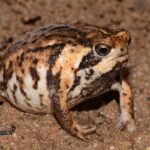- Discovering <em>Ischnocnema bocaina</em>: Secrets of Brazil’s Hidden Forest Frog
Discovering Ischnocnema bocaina: Secrets of Brazil’s Hidden Forest Frog#
In the vibrant, mysterious forests of southeastern Brazil, amid lush vegetation and whispers of rustling leaves, lives a frog that few people have had the chance to truly know—the elusive and intriguing Ischnocnema bocaina. Small, delicate, and perfectly adapted to life beneath forest canopies, this species represents both nature’s subtle artistic touch and its finely tuned machinery. Named after the Serra da Bocaina region where it was first discovered, Ischnocnema bocaina quietly occupies a vital niche in its native habitats, largely hidden from the human gaze yet integral to the ecosystem it calls home.
As we step softly into its shaded forests, we begin our journey of discovery to witness the remarkable life of a creature that remains so unknown and yet so essential. While this elegant amphibian may not boast the dazzling hues or dramatic poison warnings of its more famous cousins, its charms lie in subtler details: intricate markings, gentle cricket-like calls, and finely balanced behaviors that allow it to flourish in a changing landscape.
Taxonomy and Classification#
Ischnocnema bocaina is part of the rich amphibian tapestry within the family Brachycephalidae, an evolutionary lineage characterized by direct-developing frogs—that is, frogs that do not pass through a free-swimming tadpole stage. Instead, fully formed tiny froglets hatch directly from terrestrial eggs, a remarkable adaptation suited for humid but stream-poor forests.
The Genus: Ischnocnema#
The genus Ischnocnema, harboring over 30 distinct species, highlights the incredible biodiversity and specialization found in Brazil’s Atlantic Forest. Within this genus, species often share certain features: small to medium-sized bodies, variable coloration that aids camouflage, and a terrestrial lifestyle deeply intertwined with forest ecosystems. However, subtle genetic differences, call variations, and geographically distinct populations enable experts to discern individual species like I. bocaina clearly within the genus.
Natural Habitat#
Deep within Brazil’s breathtaking Serra da Bocaina—a mountain range straddling the states of Rio de Janeiro and São Paulo—Ischnocnema bocaina makes its home among shaded forest floors, concealed beneath leaf litter, logs, and dense ferns. This narrow geographic range endows this frog with a uniquely high conservation value, as such areas are often sensitive to environmental disturbances.
Within this ecosystem, ambient moisture, stable temperatures, and persistent shade create the perfect microhabitat conditions. These frogs rarely venture far from the damp, secure forest grounds, where their coloration and behaviors harmoniously combine to provide excellent camouflage against pervasive predators.
Microhabitat Preferences#
The living conditions preferred by Ischnocnema bocaina often include damp, decaying leaf litter which provides abundant resources—from food sources such as small arthropods, to protective shelter from predators. Their direct developmental life cycle eliminates their reliance on streams and ponds for tadpole development, freeing them to inhabit areas inaccessible to other amphibian species. This allows them to thrive in intact forest fragments, playing important roles as terrestrial insect predators and key food sources for larger forest vertebrates.
Physical Characteristics#
The first glimpse of Ischnocnema bocaina reveals a frog elegantly designed for life hidden amidst fallen leaves and earthly shadows. Small and slender, adults typically measure less than two centimeters, easily fitting onto a coin. Its muted coloration palette—varied blends of browns, grays, and occasional hints of subtle greens—creates a camouflage pattern so precise it makes this frog nearly invisible against the forest floor.
The frog possesses smooth-to-slightly-granular skin texture and relatively slender limbs, well adapted for quietly stalking tiny prey and quick, silent movements. Their large, expressive eyes are adeptly positioned to detect the slightest movement around them, helping them remain alert against potential threats. Underneath, their soft pale bellies contrast sharply with their dark dorsums, a pattern common in small terrestrial frogs across the world.
Adaptations for Survival#
Like a seasoned forest survivor, I. bocaina‘s coloration varies subtly from individual to individual, a classic case of cryptic polymorphism. This genetic benefit ensures that predators cannot easily learn to recognize a single color pattern as prey. Thanks to their direct reproductive pattern, their independence from water has made them more resilient against specific threats that traditionally impact amphibians, like aquatic pollution—although other threats remain pressing.
Behavior and Life Cycle#
With nightfall comes renewed activity for Ischnocnema bocaina. It is under moonlit forest canopies that this secretive amphibian gently moves through their tiny territories, patiently hunting for small arthropods such as mites, ants, spiders, and tiny beetles. Unlike more flamboyant frog species, their hunting is subtle—a stealthy ambush predator capable of remaining perfectly still until an unwitting insect steps within immediate striking distance.
Their calls, delicate and vibrant sounds akin to gentle cricket chirps, reverberate softly through the dense canopy at night. A male’s soft vocalizations not only attract females but also act as territorial proclamations, subtly communicating to surrounding males about boundaries. Females carefully select a mate based on acoustic signals that may indicate vigor or superiority, further ensuring strong genetic lineages.
The Magic of Direct Development#
Perhaps one of the most fascinating biological adaptations of I. bocaina is its distinctive reproductive strategy. Rather than depositing eggs in water, females lay small clutches of eggs directly onto moist terrestrial environments, hidden within piles of leaf litter or beneath the shelter of logs or stones. Embryos develop protected in their capsules, bypassing the tadpole stage altogether, and hatch into miniature froglets perfectly suited for terrestrial life. This adaptation strongly ties their survival to the continued existence of intact humid forest ecosystems and has intriguing implications for genetic isolation and diversity.
Ecological Role#
Although small, Ischnocnema bocaina plays a considerable role within the forest ecosystem. Acting primarily as insectivores, these frogs keep arthropod populations in check, directly influencing the forest’s biological balance. At the same time, they serve as vital prey to larger predators, including reptiles, birds, and mammals, contributing positively to the overall health and biodiversity of their environment.
Threats and Conservation Status#
Though officially assessed as Data Deficient by the International Union for Conservation of Nature (IUCN), close analysis reveals that I. bocaina may stand vulnerable to the troubling threats faced by much of Brazil’s Atlantic Forest—primarily habitat loss due to expanding agriculture, illegal deforestation, and unregulated tourism. Climate change, too, presents future challenges, potentially altering humidity and temperature patterns critical to the survival of this sensitive species.
Fortunately, Serra da Bocaina region includes protected conservation areas and national park designations that help mitigate some of these threats. Ongoing research into the species’ population, distribution, and threats is vital to providing adequate legal frameworks and conservation management policies.
Cultural and Scientific Significance#
In addition to its ecological importance, Ischnocnema bocaina offers researchers insight into the evolutionary marvel of terrestrial reproduction among amphibians. Studies focused on these terrestrial frogs’ genetics, evolution, and physiology continue to shape our understanding of biodiversity and adaptation patterns across Neotropical ecosystems.
Conclusion: Advocating for the Silent Frogs of Bocaina#
The gentle, hidden life of Ischnocnema bocaina reminds us of nature’s profound subtleties, highlighting creatures whose quiet existence safeguards the very fabric of their ecosystems. To truly preserve these wondrous frogs and their forests requires ongoing advocacy for habitat conservation, continued scientific attention, and increased public education of their importance.
Each individual step we undertake—from supporting sustainable forestry practices to raising awareness in local communities and online—can significantly bolster conservation outcomes for delicate species like Ischnocnema bocaina. Let their quiet song continue to resonate through Serra da Bocaina’s misty forests, unobstructed, gently guiding us toward a more thoughtful coexistence with our natural world.







